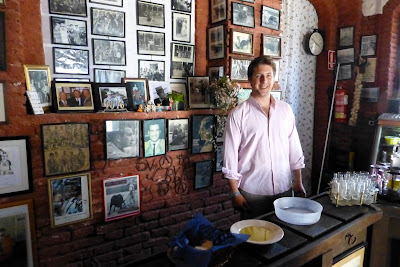 |
| Grazalema nestled at base of Sierra de Grazelema |
 |
| Fernando's leather shop |
 |
| Upstairs in workroom of leather shop. Fernando is taking measurements for the leather case he is making for my portable keyboard for my iPad. |
 |
| Leather pieces. I was able to select the leather for my case. |
 |
| Happy group. Photo taken by Fernando's wife Jo. |
 |
| Good place for coffee which John and I had while the ladies shopped for...ready for this?...scarves! |
 |
| 17th century Iglesia La Aurora on the Plaza de España |
 |
| Retired hydraulic engineer Checking out the hydraulics |
 |
| Bonnie talking to compazino about his pet dog and his two month old pet goat (whose photo I did not get). He said they don't fight because they eat different foods... |
 |
| Grazalema is nestled below a magnificent rocky outcrop known as Peñon Grande |
 |
| Overlooking Sieerra de Grazalema Natural Park |
 |
| John and Marcy feel like they are on top of the world |
Just outside Zahara we stopped at El Vinculo, an olive oil pressing and processing business, family owned. The young man in the picture below is of that family and was telling us about his great (sic) grandfather starting the business in 1755 and how it has stayed in the family up to the present. The building we were in has a retail shop where oil can be bought. On the wall behind him are photos of famous bullfighters. There is even a photo of Ernest Hemingway and another of Orson Welles, both photos taken in his grandfather's home in Ronda where both men spent a lot of time. Much of Hemmingway's "Death in the Afternoon" came from his being in Ronda and knowing people in the bullfight profession. Click Molino El Vinculo to go to the website.
 |
| He was so charming and helpful and proud of the family heritage |
 |
| Sort of a museum of artifacts from family life in the campo |
 |
| We watched a video of how they grow, harvest, and process olives to make oil. Excellently done. Unfortunately, they do not sell DVDs. |
 |
| Wider view of retail shop and "museum" |
 |
| Building housing the retail shop' |
For making the olive oil, crushed olives are spread on jute mats, one meter in diameter, then stacked very high and pressed in large hydraulic presses. The oil seeps through the mats and is collected. This is called "cold pressing'. Oil from this first pressing is called 'virgin olive oil'. There is actually no such thing as 'extra' virgin olive oil - it is either virgin or not!
 |
| Jute mats |
 |
| Hydraulic presses on far wall |
After that informative stop we drove into Zahara which has terrific views. It is a small, quiet village and is a great place to stop, rest, and have refreshment.
 |
| Town of Algodonales in the distance |
 |
| Walking from car park into village. Roof is Iglesia de Santa Maria de la Mesa |
 |
| Water is Lake Zahara, a man made reservoir. There are swimming areas - well used in summer. |
 |
| Peaceful spot to stop for coffee. John is in red shirt on left |
 |
| Iglesia de Santa María de la Mesa. |
 |
| Another way to look at Zahara - love those rooftops! |
 |
| Capilla de San Juan de Letrán |
 |
| Olvera in the distance |
 |
| Olvera via telephoto lens from Zahara de la Sierra |
 |
| Zahara de la Sierra |



Cool page. I found this as I am searching for places to taste/buy olive oil. We'll put la vincuma on the itinerary. Thanks for sharing, Gabe
ReplyDelete